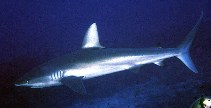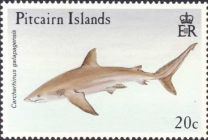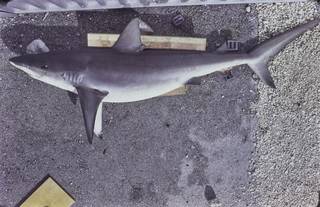WoRMS taxon details
Carcharhinus galapagensis (Snodgrass & Heller, 1905)
105790 (urn:lsid:marinespecies.org:taxname:105790)
accepted
Species
Carcharias galapagensis Snodgrass & Heller, 1905 · unaccepted
Carcharinus galapagensis (Snodgrass & Heller, 1905) · unaccepted (misspelling)
Eulamia galapagensis (Snodgrass & Heller, 1905) · unaccepted (senior synonym)
marine, brackish, fresh, terrestrial
Not documented
Description Found close inshore to well offshore near on the insular or continental shelves, on rugged coral and rocky bottoms. Capable...
Description Found close inshore to well offshore near on the insular or continental shelves, on rugged coral and rocky bottoms. Capable of crossing considerable distances of open ocean between islands (at least 50 km). Juveniles found in shallower waters. Feeds mainly on fishes and less on cephalopods and crustaceans. Viviparous (with a yolk-sac placenta), 6 to 16 young in a litter. Found in superficial aggregations. Aggresive. Incriminated in human attacks. [details]
Froese, R. and D. Pauly. Editors. (2024). FishBase. Carcharhinus galapagensis (Snodgrass & Heller, 1905). Accessed through: World Register of Marine Species at: https://www.marinespecies.org/aphia.php?p=taxdetails&id=105790 on 2024-04-23
Date
action
by
![]() The webpage text is licensed under a Creative Commons Attribution-Noncommercial 4.0 License
The webpage text is licensed under a Creative Commons Attribution-Noncommercial 4.0 License
context source (Bermuda)
Smith-Vaniz, W. F.; Collette, B. B.; Luckhurst, B. E (1999). Fishes of Bermuda: History, zoogeography, annotated checklist, and identification keys
(American Society of Ichthyologists and Herpetologists - Special Publication No.4)
. ASIH, 424 pp. [details]
context source (PeRMS) Chirichigno, N.; Cornejo, M. (2001). Catálogo comentado de los peces marinos del Perú. <em>2ª ed. Instituto del Mar de Perú. Publicación Especial. Callao.</em> 314 p. [details]
basis of record van der Land, J.; Costello, M.J.; Zavodnik, D.; Santos, R.S.; Porteiro, F.M.; Bailly, N.; Eschmeyer, W.N.; Froese, R. (2001). Pisces, <B><I>in</I></B>: Costello, M.J. <i>et al.</i> (Ed.) (2001). <i>European register of marine species: a check-list of the marine species in Europe and a bibliography of guides to their identification. Collection Patrimoines Naturels,</i> 50: pp. 357-374 (look up in IMIS) [details]
additional source King, C.M.; Roberts, C.D.; Bell, B.D.; Fordyce, R.E.; Nicoll, R.S.; Worthy, T.H.; Paulin, C.D.; Hitchmough, R.A.; Keyes, I.W.; Baker, A.N.; Stewart, A.L.; Hiller, N.; McDowall, R.M.; Holdaway, R.N.; McPhee, R.P.; Schwarzhans, W.W.; Tennyson, A.J.D.; Rust, S.; Macadie, I. (2009). Phylum Chordata: lancelets, fishes, amphibians, reptiles, birds, mammals. <em>in: Gordon, D.P. (Ed.) (2009). New Zealand inventory of biodiversity: 1. Kingdom Animalia: Radiata, Lophotrochozoa, Deuterostomia.</em> pp. 431-554. [details]
additional source Froese, R. & D. Pauly (Editors). (2023). FishBase. World Wide Web electronic publication. version (02/2023)., available online at https://www.fishbase.org [details]
context source (PeRMS) Chirichigno, N.; Cornejo, M. (2001). Catálogo comentado de los peces marinos del Perú. <em>2ª ed. Instituto del Mar de Perú. Publicación Especial. Callao.</em> 314 p. [details]
basis of record van der Land, J.; Costello, M.J.; Zavodnik, D.; Santos, R.S.; Porteiro, F.M.; Bailly, N.; Eschmeyer, W.N.; Froese, R. (2001). Pisces, <B><I>in</I></B>: Costello, M.J. <i>et al.</i> (Ed.) (2001). <i>European register of marine species: a check-list of the marine species in Europe and a bibliography of guides to their identification. Collection Patrimoines Naturels,</i> 50: pp. 357-374 (look up in IMIS) [details]
additional source King, C.M.; Roberts, C.D.; Bell, B.D.; Fordyce, R.E.; Nicoll, R.S.; Worthy, T.H.; Paulin, C.D.; Hitchmough, R.A.; Keyes, I.W.; Baker, A.N.; Stewart, A.L.; Hiller, N.; McDowall, R.M.; Holdaway, R.N.; McPhee, R.P.; Schwarzhans, W.W.; Tennyson, A.J.D.; Rust, S.; Macadie, I. (2009). Phylum Chordata: lancelets, fishes, amphibians, reptiles, birds, mammals. <em>in: Gordon, D.P. (Ed.) (2009). New Zealand inventory of biodiversity: 1. Kingdom Animalia: Radiata, Lophotrochozoa, Deuterostomia.</em> pp. 431-554. [details]
additional source Froese, R. & D. Pauly (Editors). (2023). FishBase. World Wide Web electronic publication. version (02/2023)., available online at https://www.fishbase.org [details]
 Present
Present  Present in aphia/obis/gbif/idigbio
Present in aphia/obis/gbif/idigbio  Inaccurate
Inaccurate  Introduced: alien
Introduced: alien  Containing type locality
Containing type locality
From other sources
Description Found close inshore to well offshore near on the insular or continental shelves, on rugged coral and rocky bottoms. Capable of crossing considerable distances of open ocean between islands (at least 50 km). Juveniles found in shallower waters. Feeds mainly on fishes and less on cephalopods and crustaceans. Viviparous (with a yolk-sac placenta), 6 to 16 young in a litter. Found in superficial aggregations. Aggresive. Incriminated in human attacks. [details]
| Language | Name | |
|---|---|---|
| English | Galapagos sharkdusky shark | [details] |
| German | Galapagoshai | [details] |
| Japanese | ガラパゴスザメ | [details] |
| Lithuanian | Galapaginis pilkasis ryklys | [details] |
| Modern Greek (1453-) | Καρχαρίνος των Γκαλάπαγκος | [details] |
| Spanish | tiburón de Galápagos | [details] |
| Turkish | Galapagos köpekbalığı | [details] |
| Ukrainian | Галапагосская акулаАкула сіра галапагоська | [details] |
To Barcode of Life (24 barcodes)
To Biodiversity Heritage Library (14 publications)
To Biodiversity Heritage Library (3 publications) (from synonym Carcharinus galapagensis (Snodgrass & Heller, 1905))
To Biodiversity Heritage Library (6 publications) (from synonym Carcharias galapagensis Snodgrass & Heller, 1905)
To Biological Information System for Marine Life (BISMaL) (from synonym Carcharias galapagensis Snodgrass & Heller, 1905)
To Biological Information System for Marine Life (BISMaL)
To European Nucleotide Archive (ENA)
To FishBase
To FishBase (from synonym Carcharias galapagensis Snodgrass & Heller, 1905)
To FishBase (from synonym Carcharinus galapagensis (Snodgrass & Heller, 1905))
To FishBase images (Carcharhinus galapagensis, Australia, by Randall, J.E.)
To GenBank (320 nucleotides; 89 proteins)
To GenBank (320 nucleotides; 89 proteins) (from synonym Carcharias galapagensis Snodgrass & Heller, 1905)
To Global Biotic Interactions (GloBI)
To IUCN Red List (Least Concern)
To NMNH Extant Collection (Carcharhinus galapagensis FIN027605 Slide 35 mm)
To NMNH Extant Collection (Carcharhinus galapagensis RAD107036-001)
To PESI
To ITIS
To Biodiversity Heritage Library (14 publications)
To Biodiversity Heritage Library (3 publications) (from synonym Carcharinus galapagensis (Snodgrass & Heller, 1905))
To Biodiversity Heritage Library (6 publications) (from synonym Carcharias galapagensis Snodgrass & Heller, 1905)
To Biological Information System for Marine Life (BISMaL) (from synonym Carcharias galapagensis Snodgrass & Heller, 1905)
To Biological Information System for Marine Life (BISMaL)
To European Nucleotide Archive (ENA)
To FishBase
To FishBase (from synonym Carcharias galapagensis Snodgrass & Heller, 1905)
To FishBase (from synonym Carcharinus galapagensis (Snodgrass & Heller, 1905))
To FishBase images (Carcharhinus galapagensis, Australia, by Randall, J.E.)
To GenBank (320 nucleotides; 89 proteins)
To GenBank (320 nucleotides; 89 proteins) (from synonym Carcharias galapagensis Snodgrass & Heller, 1905)
To Global Biotic Interactions (GloBI)
To IUCN Red List (Least Concern)
To NMNH Extant Collection (Carcharhinus galapagensis FIN027605 Slide 35 mm)
To NMNH Extant Collection (Carcharhinus galapagensis RAD107036-001)
To PESI
To ITIS



